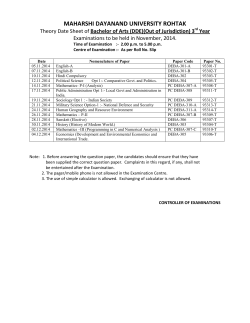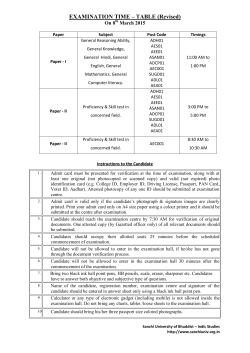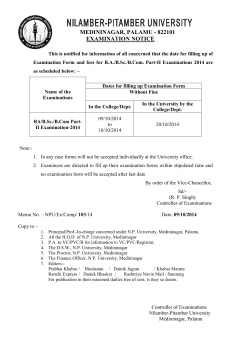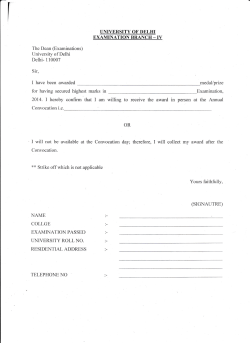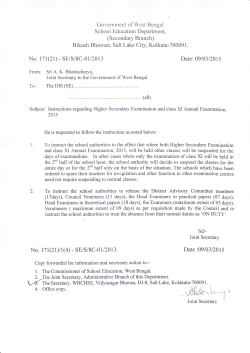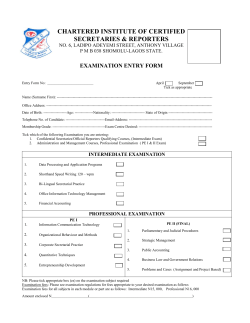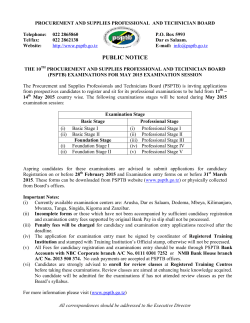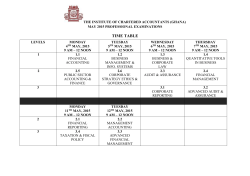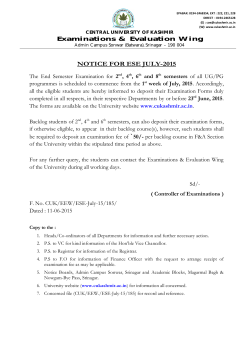
the complete Candidate Handbook - ETCP
Entertainment Technician Certification Program CANDIDATE HANDBOOK CERTIFIED RIGGER PROGRAM Effective April 2015 Copyright © 2015 PLASA Revision 4.0 published April 2015 The ETCP [and AMP] reserves the right to modify or revise, at any time and from time to time without notice, any and all aspects of the Entertainment Technician Certification Program including, without limitation, any policies, procedures, deadlines, charges and fees. All questions and requests for information about certification should be directed to: All questions and requests for information about scheduling examinations should be directed to: Entertainment Technician Certification Program Applied Measurement Professionals, Inc. 630 Ninth Avenue, Suite 609 New York, NY 10036 18000 W. 105th Street Olathe, KS 66061 Phone: (212) 244-1505 Ext. 705 Fax: (212) 244-1502 Phone: (913) 895-4600 Fax: (913) 895-4650 e-mail: etcp@plasa.org website: http://etcp.plasa.org e-mail: info@goAMP.com website: www.goAMP.com Contents Become ETCP Certified..............................5 Introduction.................................................6 About ETCP................................................6 Vision Statement.........................................6 Independent Testing Agency.......................6 Non-Discrimination Policy..........................6 ETCP Certified Rigger................................6 About the Examinations.............................7 Preparing for the Examination....................7 Web-Based Practice Exams..........................7 Examination Fees........................................8 Examination Fees Summary.....................8 Member Discount.....................................8 Multiple Examination Discount................8 Eligibility Requirements..............................9 Qualification Points Table........................9 Application................................................ 10 Examination Administration.................... 10 Holidays..................................................... 10 Registering for an Examination................ 10 Refunds...................................................... 10 Scheduling an Examination...................... 10 Schedule Online..................................... 10 Telephone Scheduling.............................. 11 Examination Content Outline Arena Entertainment Rigger..................... 14 Sample Examination Questions Arena Entertainment Rigger..................... 17 Examination Content Outline Theatre Entertainment Rigger.................. 18 Sample Examination Questions Theatre Entertainment Rigger.................. 21 Taking the Examination............................22 Identification.............................................22 Items to Bring............................................22 Security.......................................................22 Examination Time Limit...........................23 Examination Restrictions..........................23 Misconduct................................................23 Copyrighted Examination Questions.......23 Pre-Examination........................................23 Example Question on Screen................... 24 Timed Examination...................................24 Candidate Comments...............................25 Following the Examination.......................25 Pass/Fail Score Determination..................25 Scores Cancelled or Withheld by ETCP or AMP...........................................25 Assessment Center Locations.................... 11 If You Pass the Examination.....................26 Special Arrangements for Candidates with Disabilities......................................... 11 If You Do Not Pass the Examination........26 Telecommunication Devices for the Deaf.12 Examination Appointment Changes........ 12 Failing to Report for an Examination or Cancellations.........................................12 Emergency Waiver.....................................12 Inclement Weather, Power Failure or Emergency..................................................13 Test Content..............................................13 Non-Scored Items......................................13 Confidentiality...........................................26 Duplicate Score Report.............................26 ETCP Disciplinary Policy .........................26 Appeal Policy.............................................26 Regrade Policy............................................26 Renewal Policy........................................... 27 Renewing Your Certification................... 27 Code of Ethics and Professional Conduct................................28 Subject Matter Experts..............................29 ETCP Council Members...........................30 BECOME ETCP CERTIFIED Become a standout in your craft and demonstrate your dedication to professional growth by becoming ETCP Certified. Show employers that you have the qualifications and skills that they require. ETCP certification promotes safety for technicians, performers and audiences, and provides validation and public recognition of your skills. Personnel certification is the voluntary process by which a nongovernmental organization grants recognition to an individual who has demonstrated a high level of knowledge, skills and abilities. Certification means that one has met specific eligibility requirements including training, experience and education, and passed a rigorous, comprehensive examination. Certification indicates a substantial professional commitment to the field and documents this expertise to employers, colleagues and professional organizations. Feasibility surveys of employers show eighty-one percent would encourage employees or personnel working in their venues to seek certification in rigging. Establish your credibility and gain the confidence of employers and coworkers by achieving ETCP certification. INTRODUCTION INDEPENDENT TESTING AGENCY This handbook provides information about the examination and application process to become an ETCP Certified Rigger. It outlines the design and content of the examinations and guides candidates through the entire process from application to examination. For your convenience, this handbook may also be downloaded from the ETCP website at http://etcp.plasa.org. ETCP has contracted with Applied Measurement Professionals, Inc. (AMP) to assist in the development, administration, scoring and analysis of ETCP’s certification examinations. AMP, located in the greater Kansas City area, is a leading provider of licensing and certification examinations for professional organizations. ABOUT ETCP ETCP is an industry-wide program of PLASA. Participating in the governance of the program are: ACTSAFE, Alliance of Motion Picture and Television Producers (AMPTP), Broadway Across America, The Broadway League, Canadian Institute for Theatre Technology (CITT), Cirque du Soleil/MGM MIRAGE, Disney Theatrical Productions, International Alliance of Theatrical Stage Employees (IATSE), International Association of Venue Managers (IAVM), InfoComm International, Live Nation, NBC Universal, Production Resource Group (PRG), TEA, United States Institute for Theatre Technology (USITT), and Walt Disney Parks and Resorts. For more information, please visit http://etcp.plasa.org. VISION STATEMENT ETCP was created to develop a personnel certification program to recognize those individuals who have demonstrated knowledge, skills and abilities in specific disciplines within the entertainment technology field. By providing a thorough, independent assessment of knowledge, skills and abilities for entertainment technology disciplines, the Program seeks to enhance safety, reduce workplace risk, improve performance, stimulate training, and give due recognition to the professional skills of entertainment technicians. 6 NON-DISCRIMINATION POLICY ETCP and AMP do not discriminate among candidates on the basis of race, color, creed, gender, religion, national origin, ancestry, disability, military discharge status, sexual orientation, or marital status. ETCP CERTIFIED RIGGER There are currently two divisions of the main ETCP Certified Rigger credential: ‘ETCP Certified Rigger – Arena’ and ‘ETCP Certified Rigger – Theatre’. The Arena certification encompasses rigging that employs chain hoists and truss systems to temporarily suspend objects from overhead structures in any environment. ETCP recognizes that these methods and hardware are used throughout the entertainment industry in arenas, convention and trade show spaces and in theatrical venues. However the principles, practices, and components are consistent and similar in all applications and are different from those used in traditional theatrical spaces. The Theatre certification encompasses rigging that employs the use of counterweighted systems, mechanical systems and hydraulic systems, usually, but not always, permanently installed in facilities for the use of theatre technicians in the execution of their rigging responsibilities. An applicant may seek certification in either or both of these divisions. Each division has its own separate examination covering the specific knowledge, skills and abilities needed. ETCP Candidate Handbook ABOUT THE EXAMINATIONS The ETCP Certified Rigger Examinations are designed to test a well-defined body of know ledge representative of current professional practice in rigging. Successful completion of a certification examination verifies broad-based knowledge in the discipline being tested. The content of the ETCP Certified Rigger Examinations has been defined by a national job analysis study. The study involved surveying practitioners in the field to identify tasks that are performed routinely and are considered important to competent practice. The examinations have been developed through a combined effort of qualified subject matter experts and testing professionals who have constructed the examinations in accordance with the ETCP Certified Rigger Examination content outlines. Each ETCP Certified Rigger Examination consists of 150 multiple-choice questions. Each question has four alternative answers (A, B, C, D), with one of those being the correct response. Candidates will be permitted three (3) hours to complete the examination. Those who are approved by ETCP to sit for the examination and achieve a passing score will be awarded the designation of either: ETCP Certified Rigger – Arena or ETCP Certified Rigger – Theatre Applicants who achieve a passing score on both examinations will be awarded the designation: ETCP Certified Rigger – Arena and Theatre This handbook provides specific information related to the ETCP Certified Rigger Examinations. To apply for either examination, complete the application and send it along with all required supporting documents ETCP Candidate Handbook and the examination fee to ETCP. ETCP recommends that you keep copies of all materials and send all documentation by certified mail or other trackable delivery service. The handbook and all application forms can also be printed at http://etcp.plasa.org. PREPARING FOR THE EXAMINATION Your primary objective in preparing for the examination is to pass. Other objectives such as learning new material and reviewing old material are critical to this objective. Begin your study by developing your strategy for success. A good study strategy includes preparation. To prepare, determine first what you need to learn, choose your study materials, and select a quiet, comfortable place that allows you to focus. Before you begin, check to make sure you have everything you need. Try to avoid interruptions for any reason. Developing a study plan will allow you to learn the most as you study. Include setting goals in your study plan. Review what you have studied as often as possible. The more you review, the more you will retain. WEB-BASED PRACTICE EXAMS Many candidates have not taken an exam in some time and/or may be unfamiliar with computer-based testing. Fifty question webbased practice exams can provide candidates with a low cost, valuable tool for self-assessment. There is no application process for the practice exams; so any interested candidate can take the exam privately at home, at the office or on the road whenever it is most convenient. Score reports are provided to help candidates focus their studies. The exams are available for $35 at www.goamp.com. Go to “Candidates” and then follow the menu to ETCP to choose one of the three exams. 7 EXAMINATION FEES The fees for going through the application process and taking the examinations for these qualifications are: ETCP Certified Rigger – Arena $650 ETCP Certified Rigger – Theatre $650 Member Discount A discount of $100 is available to candidates who are either members or employees of a member of one of the following organizations: Alliance of Motion Picture and Television Producers (AMPTP) Canadian Institute for Theatre Technology (CITT) International Alliance of Theatrical Stage Employees (IATSE) International Association of Venue Managers (IAVM) InfoComm International The League of American Theatres and Producers PLASA TEA United States Institute for Theatre Technology (USITT) Note: You may not use multiple member discounts, a maximum of one $100 discount may be used per examination. The applicant must provide verifiable documentary evidence of current membership such as a copy of the current membership certificate or card with the application. Multiple Examination Discount If a candidate applies to sit for both the Arena and Theatre examinations, a $200 discount will be applied to the fee for the second examination. The examinations may be taken in any order. Note: To obtain this discount the candidate MUST apply for the second examination within one calendar year from the postmarked date of the first application. Examination Fees Summary Non-Member Member First Examination $650 $550 Second Rigging Examination Within 1 Year $450 $350 Second Rigging Examination After 1 Year $650 $550 Retake Fee for Failed Exam Within 2 Years $225 $175 Add $50 Add $50 Exams outside the U.S. & Canada 8 ETCP Candidate Handbook ELIGIBILITY REQUIREMENTS A candidate must be at least 21 years of age. ETCP uses a point system to determine eligibility to sit for examinations. A candidate must have 30 points to apply for either or both of the Entertainment Technician Certification Program rigging examinations. This table lists the points awarded for various work experience, training (i.e., internships or apprenticeships) and education. Points can be earned through work experience alone or through a combination of the above. If you have any questions concerning your eligibility to sit for the exam, contact etcp@plasa.org or call 212-244-1505 Ext. 705. Qualification Points Table Type of Experience Entertainment Rigging Work Experience Points Documentation Required 1 for each 100 hours 100 hour min. increment A completed Employment History form containing contact information sufficiently detailed to allow verification by ETCP. (Experience related to an academic degree cannot be used as professional work experience.) 1000 hours (10 points) in a year is equivalent to 20 hours per week Internship 1 for each 200 hours with a maximum of 5 points. A completed Applicant Evaluation form by the official representative of the internship is required. Apprenticeship 1 for each 100 hours with a maximum of 10 points A completed Applicant Evaluation form by the official representative of the apprenticeship is required. Notes: Education credits may contribute a maximum of 10 points. All degrees must be achieved from an accredited institution. Associates Degree 2 An official transcript is required from the granting institution, photocopies are not accepted. Associates Degree in entertainment technology field 3 An official transcript is required from the granting institution, photocopies are not accepted. Undergraduate Degree 3 An official transcript is required from the granting institution, photocopies are not accepted. Undergraduate Degree in entertainment technology field 7 An official transcript is required from the granting institution, photocopies are not accepted. Graduate Degree 1 An official transcript is required from the granting institution, photocopies are not accepted. Graduate Degree in entertainment technology field 3 An official transcript is required from the granting institution, photocopies are not accepted. ETCP Candidate Handbook 9 APPLICATION REGISTERING FOR AN EXAMINATION Your completed application form and all necessary supporting documentation should be submitted to ETCP (not to AMP) and will be evaluated to confirm that your qualifications meet or exceed the requirements to take the examination. If your application is rejected for any reason, including, without limitation, incomplete, inaccurate or unverifiable information then your application fee, less a $200 administration fee, will be refunded. Candidates should ensure that the ETCP Examination application has been properly completed and that the information provided is accurate. Your careful attention will enable prompt and efficient processing. Candidates will not be able to schedule an examination time with AMP until receiving written notification that the application has been accepted by ETCP. ETCP will send written notification to registered candidates with examination scheduling procedures. Examinations must be scheduled within one year of the date of the notification letter. EXAMINATION ADMINISTRATION The examinations are delivered by computer at over 190 AMP Assessment Centers geographically located throughout the United States, Canada, and select international sites. There are no application deadlines for computer based testing and a candidate may submit an application and fee at any time. The examinations are administered by appointment only, Monday through Friday at 9:00 am and 1:30 pm. Candidates are scheduled on a first-come, first-served basis. HOLIDAYS The examinations are not offered on the following holidays: New Year’s Day Martin Luther King Day Presidents’ Day Good Friday Memorial Day Independence Day (July 4) Labor Day Columbus Day Veterans Day Thanksgiving (and following Friday) Christmas Eve Day Christmas Day REFUNDS Candidates must submit the appropriate fee with the ETCP application. Payment may be made by credit card (Visa, MasterCard, or American Express), or check or money order made payable to ETCP. Examination fees are not transferable. Candidates requesting to withdraw from an examination after submitting an application, must do so within one year of the date of acceptance of the application. The examination fee will be refunded less the $200 administration charge. Credit card transactions or checks that are declined may be subject to a $25 handling fee. SCHEDULING AN EXAMINATION Upon acceptance, candidates have one year to schedule and complete their initial examination. Should a candidate need an extension due to extenuating circumstances, he/she must submit a written request to the ETCP Appeals Committee 60 days before the deadline stated in the acceptance letter. There are two ways to schedule an appointment for the examination. New Year’s Eve Day 10 ETCP Candidate Handbook Schedule Online: The candidate may schedule a testing appointment online at any time by using AMP’s online application/scheduling service. To use this service, follow these easy steps: Navigate in your browser to www.goAMP.com and select “Candidates.” Follow the simple, step-by-step instructions to select your examination program and register for an examination. OR Telephone Scheduling: Call AMP at (888) 519-9901 to schedule a testing appointment. This toll-free number is answered from 7:00 am to 9:00 pm (Central Time) Monday through Thursday, 7:00 am to 5:00 pm on Friday, and 8:30 am to 5:00 pm on Saturday. When scheduling an examination, be prepared to confirm a location and a preferred date and time for testing. When you contact AMP to schedule an examination appointment, you will be notified of the time to report to the center. Please make a note of it because you will NOT receive an admission letter. If you contact AMP by 3:00 pm Central Time on… Depending on availability, your examination may be scheduled as early as… Monday Thursday Tuesday Friday Wednesday Monday Thursday Tuesday Friday Wednesday ETCP Candidate Handbook If special accommodations are being requested, submit the Request for Special Examination Accommodations form included in this handbook prior to contacting AMP. To schedule your examination, contact AMP at (888) 519-9901. ASSESSMENT CENTER LOCATIONS AMP Assessment Centers have been selected to provide easiest accessibility to the most candidates in all states and major metropolitan areas. AMP Assessment Centers are typically located in H&R Block offices. A current listing of AMP Assessment Centers, including addresses and driving directions, may be viewed at AMP’s website located at www. goAMP.com. Specific address information will be provided when a candidate schedules an examination appointment. SPECIAL ARRANGEMENTS FOR CANDIDATES WITH DISABILITIES ETCP and AMP comply with the Americans with Disabilities Act and strive to ensure that no individual with a disability is deprived of the opportunity to take the examination solely by reason of that disability. AMP will provide reasonable accommodations for candidates with disabilities. Wheelchair access is available at all Assessment Centers. Candidates with visual, sensory or physical disabilities that would prevent them from taking the examination under standard conditions may request special accommodations and arrangements. To request special accommodations, complete the Request For Special Examination Accommodations form, provide documentation from a medical professional dated within the last five years, and submit with your application and fee at least 45 business days prior to your desired testing date. Please inform AMP of your need for special accommodations when calling to schedule your examination. 11 TELECOMMUNICATION DEVICES FOR THE DEAF AMP is equipped with Telecommunication Devices for the Deaf (TDD) to assist deaf and hearing-impaired candidates. TDD calling is available 8:30 am to 5:00 pm (CST) Monday through Friday at (913) 895-4637. This TDD phone option is for individuals equipped with compatible TDD machinery. EXAMINATION APPOINTMENT CHANGES A candidate may reschedule an examination appointment at no charge once by calling AMP at (888) 519-9901 at least two business days prior to the scheduled testing session. (See table below.) The candidate wishes to reschedule an examination but fails to contact AMP at least two business days prior to the scheduled testing session; The candidate wishes to reschedule a second time; The candidate appears more than 15 minutes late for an examination; or The candidate fails to report for an examination appointment. The candidate must pay the $150 fee and reschedule the examination within one year or all fees will be forfeited and the application will be cancelled. See page 10 for observed holidays. EMERGENCY WAIVER To reschedule the examination AMP If the examination is must be contacted by scheduled on… 3:00pm Central Time the previous... Monday Thursday Tuesday Friday Wednesday Monday Thursday Tuesday Friday Wednesday FAILING TO REPORT FOR AN EXAMINATION OR CANCELLATIONS Unless an Emergency Waiver (see below) is granted, a candidate will incur an additional $150 cancellation and rescheduling fee under any of the following circumstances: 12 Candidates who are unable to take the examination on the scheduled date may request an emergency waiver from ETCP. This waiver will allow the candidate to reschedule the examination appointment to a future date without penalty. Waivers may be granted for the following reasons: Disaster resulting in an officially declared “state of emergency;” Death of an immediate family member within 14 calendar days prior to the examination date. Copy of death certificate or obituary must be provided in order for the cancellation and rescheduling fee to be waived; or Illness or injury. A doctor’s verification is required. Please contact ETCP if you have questions or concerns about obtaining an emergency waiver. ETCP Candidate Handbook INCLEMENT WEATHER, POWER FAILURE OR EMERGENCY In the event of inclement weather or unforeseen emergencies on the day of an examination, AMP will determine whether circumstances warrant the cancellation, and subsequent rescheduling, of an examination. The examination will usually not be rescheduled if the Assessment Center personnel are able to open the Assessment Center. If power to a testing center is temporarily interrupted during an administration, your examination will restart where you left off and you may continue the examination. Candidates may contact AMP’s Weather Hotline at (913) 895-4618 (24 hours/day) prior to the examination to determine if AMP has been advised that any Assessment Centers are closed. Every attempt is made to administer the examination as scheduled; however, should an examination be canceled at an Assessment Center, all scheduled candidates will receive notification following the examination regarding rescheduling procedures. TEST CONTENT The three-hour 165 question examination is designed to assess the candidate’s knowledge of rigging practice. The examination is developed by ETCP. A group of experts drawn from a wide variety of work environments and geographical areas write the examination questions. For a list of these Subject Matter Experts see page 29. The examination consists of four-option, multiple-choice questions written at three different cognitive levels: recall, application, and analysis (see following table). These levels represent an organized way to identify the processes that practitioners utilize on the job. A description of the examination content follows on page 14. ETCP Candidate Handbook 1 Recall: The ability to recall or recognize specific information is required. 2 Application: The ability to comprehend, relate or apply knowledge to new or changing situations is required. 3 Analysis: The ability to analyze and synthesize information, determine solutions and/or evaluate the usefulness of a solution is required. NON-SCORED ITEMS There are 165 questions on each ETCP examination of which 150 are scored items. Because ETCP is testing so many candidates, it is necessary to have a large bank of questions that can be rotated, so candidates are not seeing the same test forms as their peers. The testing company, Applied Measurement Professionals (AMP) includes the 15 pretest items because it helps the exam committees collect meaningful statistics about new questions that may appear as scored questions on future examinations. By including the pretest items, all examinees are ensured their scores are the result of sound measurement practices and that scored questions are reflective of current practice. These pretest items are interspersed throughout the exam to ensure that candidates answer them with the same care as they do the scored questions. These 15 items do not count towards the pass/fail of the exam. Including pretest items is a standard practice in the credentialing world; and most examinations that are used for the purpose of issuing a credential include pretest items. 13 EXAMINATION CONTENT OUTLINE - ARENA ENTERTAINMENT RIGGER Examination Topic Number of Questions 1. PLANNING AND ENGINEERING 50 A. FORMULAS AND FORCES 1. Calculate conversions: SI (metric) - imperial (e.g. length, weight) 2. Apply mathematical formulas, including: a. Algebra b. Geometry c. Trigonometry 3. Apply general principles of forces, including: a. Force/weight b. Vectors c. Two components of force d. Point load e. Uniformly distributed load f.Indeterminate load g. Static load h. Dynamic load i.Shock load j. Environmental (e.g. wind, rain, snow, seismic) k. Tilt a 2-point object 4. Apply general principles of rigging, including: a. Breaking strength b. Object weight c. Safety issues 5. Calculate sling length and forces, including: a. Single point connection b. 2-way bridle c. 3-way bridle d. High/low bridle e. Breast-lines f.H-bridle B. GENERAL PRINCIPLES OF RIGGING 1. Apply general principles of rigging, including: a. Design factors b. Working load limit c. Efficiency (e.g. terminations, materials) d. Strength of materials e. Service factor f.D/d ratio g. Fleet angle h. Center of gravity i. Load distribution (e.g. beam formulas, simple span) j.Indeterminate structures k. Fall protection and rescue design procedures l.Inspections m. Risk management (e.g. OSHA/OHSA) C. DRAWING AND SCHEDULES 1. Identify and resolve hazardous situations 25 14 15 10 ETCP Candidate Handbook 2. 3. 4. 5. 6. 7. 8. 9. Conform rigging plot to building load limitations or obstructions Interpret facility plans (e.g. electrical, HVAC, structural steel) Interpret show plans Interpret hanging plot Generate hanging plot Perform layout - determine if adequate electrical power is available Verify assembly/integrity of objects to be lifted using stamped engineer drawings Verify assembly/integrity of objects to be lifted using allowable load charts 2. INSTALLATION 60 A. LAYOUT AND ELECTRICAL 1. Layout, including: a. Assign tasks to riggers b. Mark floor/grid c. Determine safety guidelines (e.g. fall protection, rescue) d. Establish communication procedures 2. General powered system requirements (e.g. dead haul, power assisted), including: a. Verify voltage b. Verify phasing c. Verify electrical connections d. Determine electrical system capacity B. RIGGING ATTACHMENTS 1. Rigging attachments (e.g. blocks, sheaves, anchors, points), including: a. Assemble rigging attachment hardware (e.g. hitches, pipes, clamps, anchors) b. Inspect assembled hardware (e.g. wire rope, slings, terminations) c. Attach hardware to overhead structure (e.g. clamps, hitches, eyebolts, blocks) d. Install fall protection if required 2. Attach assembled hardware to drop/hand line with: a. Knots (e.g. bowline, clove hitch, figure 8, sheet bend) b. Cable puller c. Carabiners 3. Attach items to lifting device, including: a. Inanimate objects (e.g. truss, lights, sound, scenery, video) b. Taildowns c. Attachment hardware d. Anchoring locations e. Safety equipment backups C.OPERATIONS 1. Lifting/lowering operations, including: a. Float objects b. Inspect entire system c. Perform pre-movement inspection of entire assembly d. Assign movement tasks (e.g. spotters, operators, communications) e. Establish lifting/lowering zone f.Perform bump check g. Level objects h. Raise/lower objects, periodically rechecking level i. Verify load distribution (e.g. load monitoring devices) j. Bring load to controlled stop k. Verify trim 10 ETCP Candidate Handbook 25 25 15 2. Confirm operation of control system and hoist, including: a. Emergency stop mode b. System commissioning (e.g. start-up and shut-down procedures) 3. Complete system, including: a. Verify travel path b. Verify trim heights c. Raise and lower loads 3. MATERIALS AND EQUIPMENT 40 A. PERSONNEL ACCESS EQUIPMENT 1. Select what is needed for safe access, including: a. Personnel lifts b. Ladders c. Rope access d. Fall protection e. Personal protective equipment B. RIGGING MATERIALS 1. Determine rigging materials, including: a. Trusses b. Other support structures (e.g. beams, pipe, platform) c. Chain hoist d. Other lifting devices (e.g. drum hoist, block and fall, lever hoist) e. Hardware (e.g. shackles, slings, wire rope) f.Manufacturer’s recommendations g. Components of specific systems h. Track systems (e.g. video, scenic, curtain) i. Properties of system design TOTAL QUESTIONS 10 16 30 150 ETCP Candidate Handbook SAMPLE EXAMINATION QUESTIONS - ARENA ENTERTAINMENT RIGGER Following are sample questions in the same style and similar content as will be on your examination. Use the sample questions to verify your understanding of the topics in the examination. Answers are provided for the sample questions. 1. Given the following information, what is the total static load? (Content Outline 1.A.4.b – Analysis) • • • • 40' 20" lighting truss at 9 lb/ft, suspended by two 1-ton chain hoists with 60' chain weighing 148 lb each 17 PARs weighing 9 lb each 4 Studio Spots® weighing 60 lb each 3 multicables which weigh .5 lb/ft (one running full length of the truss, one running 20', and the third running 5' onto the truss, all three multis run off the left end of the truss and drop 20' to the floor) 1,045.5 lb 1,111.5 lb 1,310.5 lb 1,424.5 lb A. B. C. D. 2. Which of the following are two main responsibilities of the ground rigger? (Content Outline 2.A.1.a – Recall) 1. 2. 3. 4. Coil cable. Assemble rigging points. Tie on rope. Tighten shackles. A. B. C. D. 1 and 2 only 1 and 4 only 2 and 3 only 3 and 4 only 3. Which of the following factors most affect the load-bearing capacity of a truss on a given span? (Content Outline 3.B.1.a – Application) A. B. C. D. height and material height and width width and material height and length Answers: 1:B, 2:C, 3:A ETCP Candidate Handbook 17 EXAMINATION CONTENT OUTLINE - THEATRE ENTERTAINMENT RIGGER Examination Topic Number of Questions 1. PLANNING AND LAYOUT 50 A. FORMULAS AND FORCES 6 1. Calculate conversions: SI (metric) - imperial (e.g. length, weight) 2. Apply mathematical formulas, including: a. Algebra b. Geometry 3. Apply general principles of forces, including: a. Force/weight b. Vectors c. Two components of force B. PRINCIPLES 44 1. Apply general principles of forces, including: a. Point load b. Uniformly distributed load c. Static load d. Dynamic load e. Shock load 2. Apply general principles of rigging, including: a. Breaking strength b. Design factors c. Working load limit d. Efficiency (e.g. terminations, materials) e. Motor service factor f. Duty cycle (e.g. component’s capacity to continuously perform, work:rest ratio) g. D/d ratio h. Fleet angle i.Center of gravity j. Load distribution (e.g. beam formulas, simple span) k. Fall protection and rescue plan l. Regulations and standards (e.g. OSHA, ANSI) m. Hazard assessment, risk mitigation 3. Determine weight of objects 4. Drawings and schedules, including: a. Conform rigging plot to building load limitations or obstructions b. Interpret facility plans (e.g. electrical, HVAC, structural steel) c. Interpret show plans d. Interpret line set schedule (e.g. hanging plot) e. Generate line set schedule 5. Calculate sling length and forces for the following: a. Single points (e.g. dead hangs) b. Bridles c. Breast-lines 6. Select means for access, including: a. Personnel lifts b. Ladders (e.g. wire rope, stepladders) c. Scaffolding, work platforms, and catwalks d. Fall protection 18 ETCP Candidate Handbook e. Personal protective gear f. Rope access (e.g. ascenders/descenders, bosun’s chairs) 7. Select rigging materials, including: a. Support structures (e.g. truss, beams, pipe, platform) b. Lifting devices (e.g. hoists, block and fall) c. Moving devices (e.g. winches) d. Hardware (e.g. shackles, slings, wire rope) e. Manufacturers recommendations/specifications/ratings 2. IMPLEMENTATION AND MANAGEMENT 50 A.MANAGEMENT 20 1. Layout, including: a. Assign tasks to riggers b. Mark floor/grid c. Determine safety guidelines (e.g. fall protection, rescue) d. Establish communication procedures e. Determine if adequate electrical power is available 2. Rigging attachments (e.g. blocks, sheaves, anchors, points), including: a. Inspect hardware (e.g. wire rope, slings, terminations) b. Verify assembly/integrity of objects to be lifted 3. Lifting/lowering operations, including: a. Perform pre- and post-movement inspection of entire assembly b. Assign movement tasks (e.g. spotters, operators, communications) c. Establish lifting/lowering zone d. Verify trim and load sharing B.IMPLEMENTATION 30 1. Rigging components (e.g. blocks, sheaves, anchors, points), including: a. Assemble rigging components (e.g. hitches, pipes, clamps, anchors) b. Attach assembled components to drop lines/hauling lines using knots, caribiners, etc. c. Attach rigging components to overhead structure (e.g. clamps, hitches, eyebolts, blocks) d. Attach objects (e.g. lights, sound, scenery) e. Attach lifting devices to objects to be lifted (e.g. wire rope, chain, rope, slings): f.Install fall protection 2. Lifting and lowering operations, including: a. Test motor operation (e.g. bump check) b. Check orientation/alignment of rigging components c. Raise/lower objects, check load distribution d. Check for obstructions (e.g. structural, permanent rigging, fire safety systems) 3. Perform risk/hazard assessment and apply mitigation procedures 3. RIGGING SYSTEMS 50 A. RIGGING SYSTEMS 1. Rigging systems (e.g. counterweight, hemp, powered and powered-assist, curtain and track, fire curtain): a. Identify components of specific systems b. Understand design properties of systems c. Install and operate spotline set(s) d. Identify attachment points (e.g. building structure, scenic elements) e. Bring load to controlled stop f. Identify inspection and maintenance requirements ETCP Candidate Handbook 19 2. Counterweight system, including: a. Raise and lower loads b. Attach, maintain, operate, remove balanced loads c. Attach,maintain, operate, remove unbalanced loads d. Secure loads e. Mark trim heights f.System alterations, including: 1. Lengthen and shorten battens 2. Marry arbors and battens 3. Re-position line sets 4. Breasting line sets 5. Determine load distribution 6. Add/remove system components 3. Hemp system, including: a. Raise and lower loads b. Attach, maintain, operate, remove balanced loads c. Attach, maintain, operate, remove unbalanced loads d. Secure loads e. Mark trim heights f. Maintain trim (e.g. level and straight) 4. Powered systems (e.g. dead haul, power assisted, chain hoist, drum hoist, line shaft), including: a. Identify system type b. Identify system capacity c. Identify system capabilities and controls d. Identify power requirements e. Raise and lower loads f.Mark trim heights g. Set limits h. Confirm operation of emergency stop mode 6. Curtain/Track, including: a. Determine track configuration b. Determine how to hang track configuration (e.g. straight, bi-part) c. Rig the curtain for operation (e.g. static, traveler, contour) d. Recognize dynamic load situations e. Operate system f. Identify components of curtain/track system (e.g. carriers, hangers, splices, sheaves) 7. Fire Curtain systems, including: a. Inspect system b. Maintain system c. Adhere to properties of the design d. Recognize hazardous situations e. Identify triggers (e.g. fusible links, cut the rope) f.Identify clutch g. Raise loads h. Lower loads TOTAL QUESTIONS 150 20 ETCP Candidate Handbook SAMPLE EXAMINATION QUESTIONS - THEATRE ENTERTAINMENT RIGGER Following are sample questions in the same style and similar content as will be on your examination. Use the sample questions to verify your understanding of the topics in the examination. Answers are provided for the sample questions. 1. A designer has specified a 3,600 lb video wall hanging from two points over the heads of the audience. Which of the following calculations shows the best eyebolt selection? (Content Outline 1.B.8.c – Analysis) *Ultimate loads are 4 times catalog WLLs. A. B. C. D. 3,600 lb / 2 x 8 / 4 = 3,600 lb (select ¾" eyebolt: WLL* 5,200 lb) 3,600 lb x 8 / 4 = 7,200 lb (select 7⁄8" eyebolt: WLL* 7,200 lb) 3,600 lb / 2 x 8 = 14,400 lb (select 1¼" eyebolt: WLL* 15,200 lb) 1,800 lb / 2 x 8 / 4 = 1,800 lb (select ½" eyebolt: WLL* 2,200 lb) 2. Which of the following is the best sequence when loading a counterweight batten? (Content Outline 2.A.4.b – Application) 1. 2. 3. 4. Load the counterweight arbor. Attach the load to the batten. Add or subtract weight from the arbor. Slowly raise the batten. A. B. C. D. 2, 4, 1, 3 2, 1, 4, 3 4, 2, 1, 3 1, 2, 3, 4 3. Which of the following would be used to attach sandbags to hemp rigging lines? (Content Outline 3.A.3.c – Recall) 1. 2. 3. 4. a sunday a knuckle buster trim chain a trim clamp A. B. C. D. 1 and 2 only 1 and 4 only 2 and 3 only 3 and 4 only Answers: 1:A, 2:B, 3:B ETCP Candidate Handbook 21 TAKING THE EXAMINATION Calculator Your examination will be given by computer at an AMP Assessment Center. You do not need any computer experience or typing skills to take your examination. On the day of your examination appointment, report to the Assessment Center no later than your scheduled examination time. Look for the signs indicating AMP Assessment Center Check-in. A CANDIDATE WHO ARRIVES MORE THAN 15 MINUTES AFTER THE SCHEDULED TESTING TIME WILL NOT BE ADMITTED. Calculations may be required on some examination questions. Only silent, non-programmable calculators without paper-tape printing capability are permitted during testing. Calculators will be checked for conformance with this regulation before candidates are allowed admission to the Assessment Center. IDENTIFICATION To gain admission to the Assessment Center, you need to present two forms of identification, one with a current photograph. Both forms of identification must be current and include the candidate’s current name and signature. The candidate will be required to sign a roster for verification of identity. Acceptable forms of photo identification include a current driver’s license with photograph, a current state identification card with photograph, a current passport, or a current military identification card with photograph. Employment ID cards, student ID cards and any type of temporary identification are NOT acceptable as the primary form of identification. YOU MUST PRESENT THE PROPER IDENTIFICATION TO GAIN ADMISSION TO THE ASSESSMENT CENTER. Failure to provide appropriate identification at the time of the examination is considered a missed appointment. There will be no refund of your testing fee. ITEMS TO BRING In addition to the identification mentioned above you will need to bring the following items with you for the examination: 22 Architects Scale Rule Some examination questions may be answered by sketching drawings using a scale rule. A standard 12" architects scale rule is recommended. SECURITY ETCP and AMP maintain examination administration and security standards that are designed to assure that all candidates are provided the same opportunity to demonstrate their abilities. The Assessment Center is continuously monitored by audio and video surveillance equipment for security purposes. The following security procedures apply during the examination: Examinations are proprietary. No cameras, notes, tape recorders, personal digital assistants (PDAs), pagers or cellular phones are allowed in the examination room. No guests, visitors or family members are allowed in the examination room or reception areas. No personal items, valuables, or weapons should be brought to the Assessment Center. Only keys and wallets may be taken into the examination room and AMP is not responsible for items left in the reception area. ETCP Candidate Handbook EXAMINATION TIME LIMIT MISCONDUCT A maximum of three (3) hours is allocated for candidates to take the examination. Candidates may wear a watch to help pace themselves if they so desire. The examination will be given only on the published examination date and time for which you registered. Individuals who engage in any of the following conduct may be dismissed from the examination; their scores will not be reported and examination fees will not be refunded. Examples of misconduct are when a candidate: Please inform the examination proctor if you need to leave the room for any reason during the examination. You will not be allowed additional time to make up any time lost while you are out of the room. Creates a disturbance, is abusive, or otherwise uncooperative; EXAMINATION RESTRICTIONS Gives or receives help or is suspected of doing so; The following rules will be strictly applied during your examination. No personal belongings calculator and scale rule allowed in the Assessment Pencils will be provided check-in. except will be Center. during You will be provided with scratch paper to use during the examination. You must return the scratch paper to the supervisor at the completion of testing, or you will not receive a score report. No documents or notes of any kind may be removed from the examination room. No questions concerning the content of the examination may be asked during the examination. Eating, drinking or smoking will not be permitted in the Assessment Center. You may take a break whenever you wish, but you will not be allowed additional time to make up for time lost during breaks. ETCP Candidate Handbook Uses electronic communications equipment such as pagers, cellular phones, or PDAs; Attempts to record examination questions or make notes; Attempts to take the examination for someone else; or Is observed with notes, books or other aids. COPYRIGHTED EXAMINATION QUESTIONS All examination questions are the copyrighted property of PLASA. It is forbidden under federal copyright law to copy, reproduce, record, distribute or display these examination questions by any means, in whole or in part. Doing so may subject you to severe civil and criminal penalties. PRE-EXAMINATION After your identification has been confirmed, you will be directed to a testing station. You will be instructed on-screen to enter your identification number. Your photograph will be taken and will remain on screen throughout your examination session. This photograph will also print on your score report. 23 Example Question on Screen Prior to attempting the examination, you will be given the opportunity to practice taking an examination on the computer. When you are comfortable with the computer testing process, you may quit the practice session and begin the timed examination. TIMED EXAMINATION Following the practice examination, you will begin the actual examination. Before beginning, instructions for taking the examination are provided on-screen. The computer monitors the time you spend on the examination. The examination will terminate if you exceed the time allowed. You may click on the “Time” box in the lower right-hand corner of the screen or select the Time key to monitor your time. A digital clock indicates the time remaining for you to complete the examination. The Time feature may be turned off during the examination. Only one examination question is presented at a time. The question number appears in the lower right hand corner of the screen. 24 Choices of answers to the examination question are identified as A, B, C, or D. You must indicate your choice by either typing in the letter in the response box in the lower left hand of the computer screen or clicking in the option using the mouse. To change your answer, enter a different option by pressing the A, B, C, or D key or by clicking on the option using the mouse. You may change your answer as many times as you wish during the examination time limit. To move to the next question, click on the forward arrow (>) in the lower right portion of the screen or select the NEXT key. This action will move you forward through the examination question by question. If you wish to review any question or questions, click the backward arrow (<) or use the left arrow key to move backward through the examination. A question may be left unanswered and answered at any time during the examination session. Questions may also be bookmarked for later review by clicking in the blank square to the right of the Time button. Click on the hand icon or select the NEXT ETCP Candidate Handbook key to advance to the next unanswered or bookmarked question on the examination. To identify all unanswered and bookmarked questions, repeatedly click on the hand icon or press the NEXT key. When the examination is completed, the number of examination questions answered is reported. If not all questions have been answered and there is time remaining, return to the examination and answer those questions. Be sure to provide an answer for each examination question before ending the examination. There is no penalty for guessing. CANDIDATE COMMENTS During the examination, online comments may be provided for any question by clicking on the button displaying an exclamation point (!) to the left of the Time button. This opens a dialogue box where comments may be entered. Comments will be reviewed, but individual responses will not be provided. FOLLOWING THE EXAMINATION After completing the examination, candidates are asked to complete a short evaluation of their testing experience. Scores are reported in written form only, in person or by U.S. mail. Scores are not reported over the telephone, by electronic mail or by facsimile. Your score report will indicate a “pass” or “fail.” Additional detail may be provided in the form of raw scores by major content category. A raw score is the number of questions you answered correctly. Your pass/fail status is determined by your raw score. PASS/FAIL SCORE DETERMINATION The methodology used to set the minimum passing score is the Angoff method, applied during the performance of a Passing Point Study by a panel of experts in the field. The experts evaluate each question on the examination to determine how many correct answers ETCP Candidate Handbook are necessary to demonstrate the knowledge and skills required to pass the examination. Your ability to pass the examination depends on the knowledge and skills you display, not on the performance of other candidates. Passing scores vary slightly for each version of the examination. To ensure fairness to all candidates, a process of statistical equating is used. This involves selecting an appropriate mix of individual questions for each version of the examination that meet the content distribution requirements of the examination content blueprint. Because each question has been pretested, a difficulty level can be assigned. The process then considers the difficulty level of each question selected for each version of the examination, attempting to match the difficulty level of each version as closely as possible. To assure fairness, slight variations in difficulty level are addressed by adjusting the passing score up or down, depending on the overall difficulty level statistics for the group of scored questions that appear on a particular version of the examination. SCORES CANCELLED OR WITHHELD BY ETCP OR AMP ETCP and AMP are responsible for the validity and integrity of the scores they report. On occasion, occurrences such as computer malfunction or misconduct by a candidate may cause a score to be suspect. ETCP and AMP reserve the right to void or withhold examination results if, upon investigation, violation of its regulations is discovered. In addition, the ETCP Council reserves the right to periodically withhold examination scores to conduct a review for quality assurance. You will be notified by ETCP if your examination scores will be temporarily withheld for any reason. 25 IF YOU PASS THE EXAMINATION Candidates who pass the examination will receive: A certificate from the ETCP detailing your qualification as an ETCP Certified Rigger A credit-card sized ETCP Certified Rigger identification card with your photograph A pin, patch, and sticker identifying you as an ETCP Certified Rigger IF YOU DO NOT PASS THE EXAMINATION Candidates who do not pass an ETCP Examination may re-register with ETCP for the same examination twice more within two years without submitting a new application and supporting documents. The full retake fee of $200 ($150 for members - see Examination Fees on Page 8), is payable for each re-registration along with a signed letter of intent. If the candidate is not successful in these three attempts, he/she must wait one year before reapplying and the full application and fee must be submitted at that time. CONFIDENTIALITY Information about candidates and their examination results is considered confidential. Studies and reports concerning candidates will contain no information identifiable with any candidate, unless authorized by the candidate. DUPLICATE SCORE REPORT Candidates may purchase additional copies of their results at a cost of $25 per copy. Requests must be submitted to AMP, in writing. The request must include the candidate’s name, examination identification number, mailing address, telephone number, date of examination and examination taken. Submit 26 this information with the required fee payable to AMP in the form of a money order or cashier’s check. Duplicate score reports will be mailed within approximately two weeks after receipt of the request and fee. ETCP DISCIPLINARY POLICY When a person applies for ETCP certification, he/she agrees to abide by the Code of Ethics and Professional Conduct listed herein (or in subsequent revisions). If someone believes that a Certified Entertainment Technician has not abided by one or more of the “Code of Ethics and Professional Conduct” (Page 28), he/she can submit a complaint in writing outlining which standards were violated along with documentation of the claim. Complaints will be reviewed within 120 days. APPEAL POLICY Within 30 days of the date of the notification letter informing the candidate of a negative determination (rejection of application or failed examination), the candidate may appeal by submitting a written explanation of the reason for refuting the negative determination. All materials must be submitted in writing to ETCP, 630 Ninth Avenue, Suite 609, New York, NY 10036. Candidates will be notified in writing of receipt of their appeal. Candidates will be informed of their appeal status in writing after a decision has been reached. All appeal decisions shall be made within 120 days. Appeal results will not be available by telephone. REGRADE POLICY Within 30 days of the date of the notification letter informing the candidate of a failed examination, the candidate may request his or her examination be regraded for a $25 administrative fee payable to ETCP. Requests must be submitted in writing to ETCP, 630 Ninth Avenue, Suite 609, New York, NY 10036. ETCP Candidate Handbook RENEWAL POLICY Continued training and professional development activities are essential in the changing entertainment technology environment. Therefore, to maintain the ETCP certification, a certified entertainment rigger must accumulate 40 renewal credits of continued training/professional development OR retake the certification examination and accumulate a minimum of 10 renewal credits of continued training/professional development over the 5 year period following the examination - see table below. Documentation of these credits must be submitted along with the renewal fee and approved every 5 years from the date of initial certification. Renewing Your Certification Type of Experience Renewal Credits Maximum Credits Entertainment Rigging Work Experience 1 renewal credit per 40 hours of documented experience. Experience must be documented with (but not limited to) dates of work, supervisors’ names and contact information, location, and type of work. 30 Attending ETCP Recognized Training Course 1 renewal credit per credit hour (See http://etcp.plasa.org for information on recognized courses.) 30 Attending Course taught by an ETCP Recognized Trainer 1 renewal credit per credit hour (See http://etcp.plasa.org for information on recognized trainers.) 30 Attending Non-ETCP Recognized Training Course 0.5 renewal credit per credit hour (Training courses directly related to rigging practices, safety, or engineering.) 30 Attending Course taught by a Non- ETCP Recognized Trainer 0.5 renewal credit per credit hour (Training courses directly related to rigging practices, safety, or engineering.) 30 Standards Writing in Entertainment Rigging 1 renewal credit per hour of scheduled meetings (Attendance must be verifiable by PLASA, ANSI, NFPA, or other relevant standards drafting organization.) 20 Trainer for an ETCP Recognized Course or ETCP Recognized Trainer 1.5 renewal credits per credit hour (See http://etcp.plasa. org for information on recognized courses.) 30 Trainer for a Non-ETCP Recognized Course or Non-ETCP Recognized Trainer 1 renewal credits per credit hour (Training courses directly related to rigging practices, safety, or engineering.) 30 Taking the ETCP Examination 30 renewal credits for a passing score (Examination must be completed prior to the cut-off date.) 30 ETCP Candidate Handbook 27 ETCP Certified Entertainment Technician Code of Ethics and Professional Conduct This sets forth the code of ethics and professional standards to be observed by holders of documents of certification conferred by the Council of the Entertainment Technician Certification Program (ETCP). Certificants shall, in their professional activities, sustain and advance the integrity, honor, and prestige of this profession by adherence to these standards: 1Hold paramount the safety and health of people, the protection of the environment, and the protection of property in the performance of professional duties and exercise their obligation to advise employers, clients, employees, bystanders, and appropriate authorities of danger and unacceptable risks. 2Maintain honesty, fairness, impartiality; act with responsibility and integrity. Adhere to high standards of ethical conduct with balanced care for the interests of the public, employers, clients, employees, colleagues, and the profession. Avoid all conduct or practice which is likely to discredit the profession or deceive the public. 3Issue public statements only in an objective and truthful manner and only when founded upon full knowledge of the facts and competence in the subject matter. 4Undertake assignments only when qualified by education, training, or experience in the specific technical fields involved; and accept responsibility to maintain and continue one’s professional development and competence. 5Avoid actions which falsify or misrepresent one’s professional qualifications or misrepresent or exaggerate one’s degree of responsibility in, or for, the subject matter of prior assignments, or in the solicitation of employment. 6Act in a manner free of bias with regard to religion, ethnicity, gender, age, national origin, disability, or sexual orientation. More information about the Disciplinary Policy is available in writing from ETCP. 28 ETCP Candidate Handbook Subject Matter Experts Pat Bash Eric McAfee Roy Bickel Joseph McGeough John Bleich Brian Miller Eddie Blue Joe Mooneyham David Boevers Walter Murphy Marcel Boulet Mark O’Brien Eric Braun Rocky Paulson Olan Cottrill G. Anthony Phillips Dan Culhane Eddie Raymond Brad Dittmer Michael Reed James Doherty Eric Rouse Harry Donovan Bill Sapsis Russ Dusek Peter Scheu Tony Galuppi Loren Schreiber Kelly Green Karen Seifried Tom Heemskerk Scott Sloan Dan Houser Sammy Stokes Glenn Hufford Edward Kish Jack Suesse Gil Vinzant Stéphane Mayrand ETCP Candidate Handbook 29 ETCP Council Members ORGANIZATIONAL MEMBERS PLASA Tim Hansen (Council Chair) Industrial Sales Manager for Oasis Stage Werks International Association of Venue Managers (IAVM) Russell Read Director of Operations, AT&T Center Scott Hoyt PLASA North American Regional Board Treasurer and Vice President and Business Manager Heartland Scenic Studio Eddie Raymond PLASA North American Regional Board Chair, and Vice President of IATSE Local 16 in San Francisco ACTSAFE Geoff Teoli InfoComm International Andre LeJeune InfoComm Staff Instructor TEA Michael Finney Director of Technical Design for Thinkwell Design & Production Executive Director Alliance of Motion Picture and Television Producers (AMPTP) Matt Antonucci Vice President Production Affairs and Safety Canadian Institute for Theatre Technology (CITT) United States Institute for Theatre Technology (USITT) Joe Aldridge USITT Past President, and Professor of Theatre and Technical Director at University of Nevada Las Vegas Dennis Dorn Professor Emeritus of Theatre Technology at the University of Wisconsin-Madison Monique Corbeil CITT National Coordinator International Alliance of Theatrical Stage Employees (IATSE) Brian Lawlor International Representative Pat White Director of Education and Training 30 ETCP Candidate Handbook ETCP Council Members BUSINESS MEMBERS Broadway Across America NBC Universal Mark Bumgardner National Director of Production/Theatrical Cirque du Soleil / MGM MIRAGE Paul Jordan Vice President, Production Safety Greg Petruska Director, Environmental Health and Safety David Chabira Production Resource Group Director of Show Support Martin Crawford Technical Manager, Technical & Show Support Resident Show Division Disney Theatrical Productions Mark Elliott Fred Gallo President - Scenic Operations Jere Harris Chairman and Chief Executive Officer Orestes Mihaly Vice President of PRG Services Director, Corporate Safety PSAV Live Nation Todd Spencer Vice President of Global Rigging Services Isaac Thompson Operations Manager, Susquehanna Center Walt Disney Parks and Resorts David Miller Manager Technical Direction & Systems SME CHAIRS Rigging Skills Electrical Skills Karen Butler Alan Rowe Owner of Suddenly Scenic Safety and Training Director of IATSE Local 728 and Chair of IATSE’s Craft Advancement Program Bill Sapsis President of Sapsis Rigging, Inc. Ken Vannice Former Engineering Project Manager for Dimming and Compliance Manager for Leviton Lighting Management Systems INDIVIDUAL MEMBERS Steven Ehrenberg Director of Production, Kings Theatre Tony Galuppi National Rigging Manager VER Sales ETCP Candidate Handbook Dr. Marilyn Hetzel Professor and Director of Theatre at Metropolitan State College of Denver Kent Jorgensen Safety and Training Representative for IATSE Local 80 and Chair of the IATSE Labor/Management Safety Committee 31 Entertainment Technician Certification Program 630 Ninth Avenue, Suite 609 New York, New York 10036 Phone: (212) 244-1505 / Fax: (212) 244-1502 etcp@plasa.org http://etcp.plasa.org 32 ETCP Candidate Handbook
© Copyright 2025
